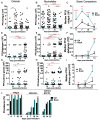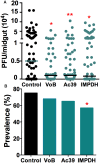Aedes aegypti Molecular Responses to Zika Virus: Modulation of Infection by the Toll and Jak/Stat Immune Pathways and Virus Host Factors
- PMID: 29109710
- PMCID: PMC5660061
- DOI: 10.3389/fmicb.2017.02050
Aedes aegypti Molecular Responses to Zika Virus: Modulation of Infection by the Toll and Jak/Stat Immune Pathways and Virus Host Factors
Abstract
Zika (ZIKV) and dengue virus (DENV) are transmitted to humans by Aedes mosquitoes. However, the molecular interactions between the vector and ZIKV remain largely unexplored. In this work, we further investigated the tropism of ZIKV in two different Aedes aegypti strains and show that the virus infection kinetics, tissue migration, and susceptibility to infection differ between mosquito strains. We also compare the vector transcriptome changes upon ZIKV or DENV infection demonstrating that 40% of the mosquito's midgut infection-responsive transcriptome is virus-specific at 7 days after virus ingestion. Regulated genes included key factors of the mosquito's anti-viral immunity. Comparison of the ZIKV and DENV infection-responsive transcriptome data to those available for yellow fever virus and West Nile virus identified 26 genes likely to play key roles in virus infection of Aedes mosquitoes. Through reverse genetic analyses, we show that the Toll and the Jak/Stat innate immune pathways mediate increased resistance to ZIKV infection, and the conserved DENV host factors vATPase and inosine-5'-monophosphate dehydrogenase are also utilized for ZIKV infection.
Keywords: Aedes aegypti; Zika virus; dengue virus; innate immunity; vector competence.
Figures




Similar articles
-
Distinct Roles of Hemocytes at Different Stages of Infection by Dengue and Zika Viruses in Aedes aegypti Mosquitoes.Front Immunol. 2021 May 13;12:660873. doi: 10.3389/fimmu.2021.660873. eCollection 2021. Front Immunol. 2021. PMID: 34093550 Free PMC article.
-
Juvenile Hormone-Sensitive Ribosomal Activity Enhances Viral Replication in Aedes aegypti.mSystems. 2021 Jun 29;6(3):e0119020. doi: 10.1128/mSystems.01190-20. Epub 2021 May 26. mSystems. 2021. PMID: 34061577 Free PMC article.
-
Evidence for infection but not transmission of Zika virus by Aedes albopictus (Diptera: Culicidae) from Spain.Parasit Vectors. 2019 May 3;12(1):204. doi: 10.1186/s13071-019-3467-y. Parasit Vectors. 2019. PMID: 31053164 Free PMC article.
-
Molecular pathogenesis of dengue virus infection in Aedes mosquitoes.J Insect Physiol. 2022 Apr;138:104367. doi: 10.1016/j.jinsphys.2022.104367. Epub 2022 Feb 4. J Insect Physiol. 2022. PMID: 35131236 Review.
-
Immune Response to Dengue and Zika.Annu Rev Immunol. 2018 Apr 26;36:279-308. doi: 10.1146/annurev-immunol-042617-053142. Epub 2018 Jan 18. Annu Rev Immunol. 2018. PMID: 29345964 Free PMC article. Review.
Cited by
-
Pathogen blocking in Wolbachia-infected Aedes aegypti is not affected by Zika and dengue virus co-infection.PLoS Negl Trop Dis. 2019 May 20;13(5):e0007443. doi: 10.1371/journal.pntd.0007443. eCollection 2019 May. PLoS Negl Trop Dis. 2019. PMID: 31107912 Free PMC article.
-
Differential STAT gene expressions of Penaeus monodon and Macrobrachium rosenbergii in response to white spot syndrome virus (WSSV) and bacterial infections: Additional insight into genetic variations and transcriptomic highlights.PLoS One. 2021 Oct 15;16(10):e0258655. doi: 10.1371/journal.pone.0258655. eCollection 2021. PLoS One. 2021. PMID: 34653229 Free PMC article.
-
Unveiling Wolbachia transcriptomic signature in the arboviral vector Aedes aegypti.Front Cell Infect Microbiol. 2025 Apr 28;15:1538459. doi: 10.3389/fcimb.2025.1538459. eCollection 2025. Front Cell Infect Microbiol. 2025. PMID: 40357403 Free PMC article.
-
Clustered rapid induction of apoptosis limits ZIKV and DENV-2 proliferation in the midguts of Aedes aegypti.Commun Biol. 2021 Jan 15;4(1):69. doi: 10.1038/s42003-020-01614-9. Commun Biol. 2021. PMID: 33452408 Free PMC article.
-
Evidence of a conserved mammalian immunosuppression mechanism in Lutzomyia longipalpis upon infection with Leishmania.Front Immunol. 2023 Nov 2;14:1162596. doi: 10.3389/fimmu.2023.1162596. eCollection 2023. Front Immunol. 2023. PMID: 38022562 Free PMC article.
References
-
- Adelman Z. N., Anderson M. A. E., Wiley M. R., Murreddu M. G., Samuel G. H., Morazzani E. M., et al. (2013). Cooler temperatures destabilize RNA interference and increase susceptibility of disease vector mosquitoes to viral infection. PLOS Negl. Trop. Dis. 7:e2239. 10.1371/journal.pntd.0002239 - DOI - PMC - PubMed
Grants and funding
LinkOut - more resources
Full Text Sources
Other Literature Sources
Molecular Biology Databases

